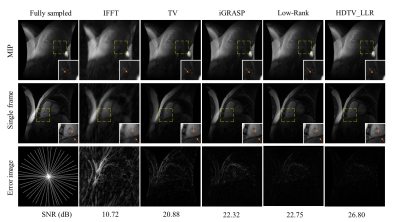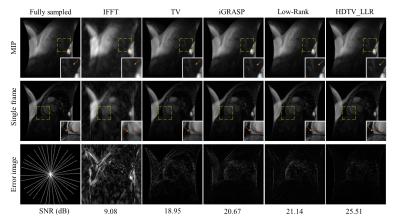Yue Hu1, Disi Lin1, and Dong Nan2
1Harbin Institute of Technology, Harbin, China, 2The First Affiliated Hospital of Harbin Medical University, Harbin, China
1Harbin Institute of Technology, Harbin, China, 2The First Affiliated Hospital of Harbin Medical University, Harbin, China
We propose a 4D MRI reconstruction algorithm, named HDTV-LLR, by integrating higher degree total variation and local low-rank penalties. Reconstruction results of a 4D cardiac data from 12- and 16-fold undersampled measurements show the improved performance.

Figure 2. Compressed sensing recovery of 12-fold undersampled 4D MRI data. The figures show the comparisons of the proposed HDTV-LLR method with zero-filling reconstruction, 4D-TV, iGRASP, and the local low-rank scheme. The first row shows the maximum intensity projection (MIP) images in one time frame. The middle row shows one slice image of the data. The first image in the last row illustrates the undersampling pattern for one slice, and the rest images show the error images. The arrows highlight regions where HDTV-LLR preserves fine details better compared with the other methods.

Figure 3. Comparisons of the proposed HDTV-LLR method against the other schemes. The acceleration factor is around 16 (17 golden angle radial lines per slice). The first row shows the maximum intensity projection (MIP) images in one time frame. The middle row shows one slice image of the data. The first image in the last row illustrates the undersampling pattern for one slice, and the rest images show the error images with respect to the full sampled data. The arrows indicate that HDTV-LLR has better performance in recovering the subtle features compared with the other methods.